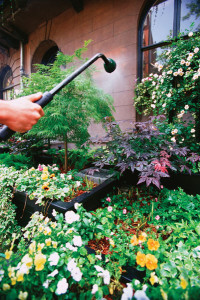 Water in the form of rain can be a blessing or a curse. We’ve certainly seen the extremes in the last two years.
Water in the form of rain can be a blessing or a curse. We’ve certainly seen the extremes in the last two years.
Life, and in this case nature, has a way of slapping us across the face without leaving a mark, waking us up to the reality that we can’t control a darn thing as much as we think we can.
We want lush growth. We just don’t want to water during the summer, allowing nature to take care of that for us. We got bit, and bit hard, last summer.
There are ways we can reduce our watering needs during the summer.
First, don’t grow anything. It’s the easiest. Don’t try for a lawn; allow the weeds to take over. Mow them occasionally to keep them the same height. Remember, if you live in the country, few folks can tell the difference between turfgrass and weeds at 60 miles per hour, unless the plants are blooming.
Avoid planting a vegetable garden. It sucks up water like nobody’s business. Same with fruit trees. Think grocery store and farmers markets.
Flowers? Forget it. Only the permanent botanicals (a fancy way of saying plastic or silk) can live without watering. They’ll look good until the sun fades them just like the real ones.
There’s not much we can do about trees and shrubs if they’re already there. We can hope they have a dense enough root system that we don’t have to worry about them. Most of them recovered during the winter when moisture levels encouraged roots to re-grow. Hooray for them!
Most evergreens are a little tougher, though as we saw last year, arborvitaes (evergreens from the cypress family) are wimps. Quite a few gave up during the drought.
Of course this entire laissez faire attitude flies in the face of what we want.
Seriously, when sticking a plant in the ground, consider its water needs. If it would thrive in a rice paddy, it’s probably not a wise candidate for the Midwest.
Is there a water source handy? Dragging a hose to the plant is better than thinking “Gosh, I wish I could drag a hose to the plant.” As the realtors say: “location, location, location.”
Think about the surrounding plants. If one is a water sponge and the other can tolerate dry conditions, don’t put them side-by-side. Put similar plants next to each other.
A few other quick tips:
• Water in the morning. 5 a.m. is a great time. Less water evaporates and more absorbs in the soil. Morning watering cuts down on diseases. Can’t handle the early dawn? Get some programmable timers for less than $25 at a hardware store.
• Water deeply once or twice a week. Daily waterings only lead to shallow roots, which need more watering. Force the roots to go deep where it’s cooler.
• Mulch with 3 to 4 inches of material. For trees and shrubs, mulching out to the drip line is ideal, though that might cut down the quality of the grass. Use a ruler, don’t guess. Most people are wrong.
• Place a value on plants if water is limited. Water trees first followed by the shrubs. Next comes the fruit trees. Further down the list are the perennial flowers. That’s it. Forget the vegetables, which can be purchased at the store along with annual flowers. Grass, as we saw last year, can fend for itself.
• Start collecting rain. Rain barrels are great but most people need about 10 instead of the feel-good one or two. In the olden days there were cisterns which were great reservoirs of water. If there’s an old one, see if it’s usable.
• Use drip irrigation hoses to place water where it really is needed and not where it won’t do any good.
Finally, any communications with any type of higher being of your choice can’t hurt.








